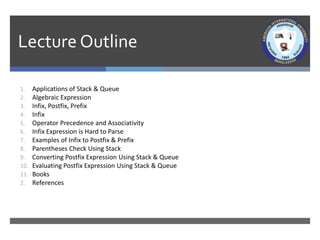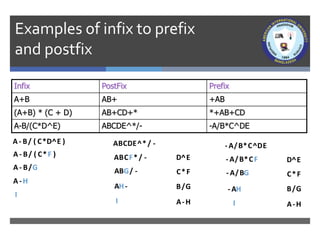Lecture_04.2.pptx
- 1. Stack & QueueApplications Course Code: CSC 2106 Dept. of Computer Science Faculty of Science and Technology Lecturer No: 4.2 Week No: 5 Semester: Spring 20-21 Lecturer: Nazia Alfaz [email protected] Course Title: Data Structure (Theory)
- 2. Lecture Outline 1. Applications of Stack & Queue 2. Algebraic Expression 3. Infix, Postfix, Prefix 4. Infix 5. Operator Precedence and Associativity 6. Infix Expression is Hard to Parse 7. Examples of Infix to Postfix & Prefix 8. Parentheses Check Using Stack 9. Converting Postfix Expression Using Stack & Queue 10. Evaluating Postfix Expression Using Stack & Queue 11. Books 2. References
- 3. Applications of Stack & Queue Syntax parsing, Parenthesis check [Stack] Expression evaluation and Expression conversion. [Stack & Queue] [Can also be achieved using only Stack] Banking Transaction View [Stack] You view the last transaction first. Backtracking and implementation of recursive function, calling function. [Stack] Towers of Hanoi [Stack] Keeping Track of Printing Jobs [Queue]
- 4. Algebraic Expression An algebraic expression is a legal combination of operands and the operators. Operand is the quantity (unit of data) on which a mathematical operation is performed. Operand may be a variable like x,y,z or a constant like 5,4,0,9,1 etc. Operator is a symbol which signifies a mathematical or logical operation between the operands. Example of familiar operators include +,-,*,/,^,% Considering these definitions of operands and operators now we can write an example of expression as: x + y * z
- 5. Infix, Postfix and Prefix Expressions INFIX: The expressions in which operands surround the operator, i.e. operator is in between the operands. e.g. x+y, 6*3 etc. The infix notation is the general way we write an expression. POSTFIX: Also Known as Reverse Polish Notation (RPN). The operator comes after the operands, i.e. operator comes post of the operands, so the name postfix. e.g. xy+, xyz+* etc. PREFIX: Also Known as Polish notation. The operator comes before the operands, i.e. operator comes pre of the operands, so the name prefix. e.g. +xy, *+xyz etc.
- 6. Infix To our surprise INFIX notations are not as simple as they seem specially while evaluating them. To evaluate an infix expression we need to consider Operators’ Precedence and Associative property For example expression 3+5*4 evaluate to 32 = (3+5)*4 or 23 = 3+(5*4) Operator precedence and associativity governs the evaluation order of an expression. An operator with higher precedence is applied before an operator with lower precedence. Same precedence order operator is evaluated according to their associativity order.
- 7. Infix To our surprise INFIX notations are not as simple as they seem specially while evaluating them. To evaluate an infix expression we need to consider Operators’ Precedence and Associative property For example expression 3+5*4 evaluate to 32 = (3+5)*4 - Wrong or 23 = 3+(5*4) - Correct Operator precedence and associativity governs the evaluation order of an expression. An operator with higher precedence is applied before an operator with lower precedence. Same precedence order operator is evaluated according to their associativity order.
- 10. Infix Expression Is HardTo Parse Need operator priorities, tie breaker, and delimiters. This makes the evaluation of expression more difficult than is necessary for the processor. Both prefix and postfix notations have an advantage over infix that while evaluating an expression in prefix or postfix form we need not consider the Precedence and Associative property. The expression is scanned from user in infix form; it is converted into prefix or postfix form and then evaluated without considering the parenthesis and priority of the operators. So, it is easier (complexity wise) for the processor to evaluate expressions that are in these forms.
- 11. Infix PostFix Prefix A+B AB+ +AB (A+B) * (C + D) AB+CD+* *+AB+CD A-B/(C*D^E) ABCDE^*/- -A/B*C^DE ABCDE^* / - A - B/ ( C*D^E ) A- B/ ( C*F ) A- B/G A-H I ABCF* / - D E ^ C F * ABG/ - B G / AH- A H - I - A/B*C^DE D E ^ C F * B G / A H - I - A/B*CF - A/BG - AH Examples of infix to prefix and postfix
- 12. Evaluation Infix Postfix Prefix (X+Y) * (M-N) XY+MN-* *+XY-MN (2+4) * (8-6) 24+86-* *+24-86 6*2 62* *62 12 12 12 Let, X=2; Y=4; M=8; N=6 Infix = <operand> <operator> <operand> Postfix = <operand> <operand> <operator> Prefix = <operator> <operand> <operand>
- 13. Parentheses Check Using Stack Using Stack, we can check whether an expression has its parenthesis properly placed; i.e., whether its opening and closing parentheses match with each other. For example, let’s take the expression (x{x[]}x) We will read the expression as a string and for each character we will do the following three things: 1. Whenever we get an opening parenthesis, we will push it into the stack. 2. When we get a closing parenthesis we will check that with the top of the stack. If the top of the stack has the same type of opening parenthesis, we will pop it. 3. We skip the character in the string which is not a parenthesis. Finally if you have reached the end of the expression and the stack is also empty, that means the expression is “well formed”. In any other case, the expression is “not well formed”.
- 14. Parentheses Check Using Stack (x{x[]}x) We will read the expression as a string and for each character we will do the following three things: 1. Whenever we get an opening parenthesis, we will push it into the stack. 2. When we get a closing parenthesis we will check that with the top of the stack. If the top of the stack has the same type of parenthesis but an opening one, we will pop it. 3. We skip the character in the string which is not a parenthesis. This expression is “well formed”
- 15. 2 * 6 / ( 4 - 1 ) + Infix Expression: 2*6/(4-1)+5*3 Add ')' to the end of Infix; Push( '(' ); do{ OP = next symbol from left of Infix; if OP is OPERAND then EnQueue( OP ); else if OP is OPERATOR then{ if OP = '(' then Push( OP ); else if OP = ')' then{ while TopElement() != '(' do{ Enqueue(TopElement()); Pop(); } Pop(); }else{ while Precedence( OP ) <= Precedence( TopElement() ) do{ Enqueue(TopElement()); Pop(); } Push( OP ); } }while !IsEmpty(); Infix Postfix Stack 2 * 6 / ( 4 - 1 ) + 2 6 * 4 1 - / 5 3 * + * ( - * / + OPERATOR OPERAND / = StackTop( * ) * StackTop( ( ) / StackTop( ( ) ( ) + < StackTop( / ) + StackTop( ( ) * StackTop( + ) End of Expression ( - StackTop( ( ) Converting Infix to Postfix Using Stack & Queue
- 16. 2 6 * 4 1 - / 5 3 * + ) Evaluating Postfix Expression Using Stack & Queue Postfix Expression: 26*41-/53*+ EnQueue( ')' ); while ( FrontElement() != ')' ) do{ OP = FrontElement(); DeQueue(); if OP is OPERAND then Push( OP ); else if OP is OPERATOR then{ OperandRight = TopElement(); Pop(); OperandLeft = TopElement(); Pop(); x = Evaluate(OperandLeft, OP, OperandRight); Push(x); } } Result = TopElement(); Pop(); cout << Result; Postfix Stack 2 6 * 4 1 - / 5 3 * + 2 4 1 3 6 12 OPERATOR OPERAND Evaluate( 2, '*', 6 ) = 12 Evaluate( 4, '+', 15 ) = 19 ‘)‘ Evaluate( 5, '*', 3 ) = 15 Evaluate( 12, '/', 3 ) = 4 Evaluate( 4, '-', 1 ) = 3 End of Expression ) 4 5 3 15 19 Expression Result = 19
- 17. Books “Schaum's Outline of Data Structures with C++”. By John R. Hubbard “Data Structures and Program Design”, Robert L. Kruse, 3rd Edition, 1996. “Data structures, algorithms and performance”, D. Wood, Addison-Wesley, 1993 “Advanced Data Structures”, Peter Brass, Cambridge University Press, 2008 “Data Structures and Algorithm Analysis”, Edition 3.2 (C++ Version), Clifford A. Shaffer, Virginia Tech, Blacksburg, VA 24061 January 2, 2012 “C++ Data Structures”, Nell Dale and David Teague, Jones and Bartlett Publishers, 2001. “Data Structures and Algorithms with Object-Oriented Design Patterns in C++”, Bruno R. Preiss,


![Applications of Stack & Queue
Syntax parsing, Parenthesis check [Stack]
Expression evaluation and Expression conversion. [Stack & Queue] [Can also be
achieved using only Stack]
Banking Transaction View [Stack]
You view the last transaction first.
Backtracking and implementation of recursive function, calling function. [Stack]
Towers of Hanoi [Stack]
Keeping Track of Printing Jobs [Queue]](https://image.slidesharecdn.com/lecture04-220805161258-5957f34b/85/Lecture_04-2-pptx-3-320.jpg)









![Parentheses Check Using Stack
Using Stack, we can check whether an expression has its parenthesis properly placed; i.e.,
whether its opening and closing parentheses match with each other. For example, let’s
take the expression (x{x[]}x)
We will read the expression as a string and for each character we will do the following
three things:
1. Whenever we get an opening parenthesis, we will push it into the stack.
2. When we get a closing parenthesis we will check that with the top of the stack. If the
top of the stack has the same type of opening parenthesis, we will pop it.
3. We skip the character in the string which is not a parenthesis.
Finally if you have reached the end of the expression and the stack is also empty, that
means the expression is “well formed”. In any other case, the expression is “not well
formed”.](https://image.slidesharecdn.com/lecture04-220805161258-5957f34b/85/Lecture_04-2-pptx-13-320.jpg)
![Parentheses Check Using Stack
(x{x[]}x)
We will read the expression as a string and for each character we will do the following
three things:
1. Whenever we get an opening parenthesis, we will push it into the stack.
2. When we get a closing parenthesis we will check that with the top of the stack. If
the top of the stack has the same type of parenthesis but an opening one, we will
pop it.
3. We skip the character in the string which is not a parenthesis.
This expression is
“well formed”](https://image.slidesharecdn.com/lecture04-220805161258-5957f34b/85/Lecture_04-2-pptx-14-320.jpg)



